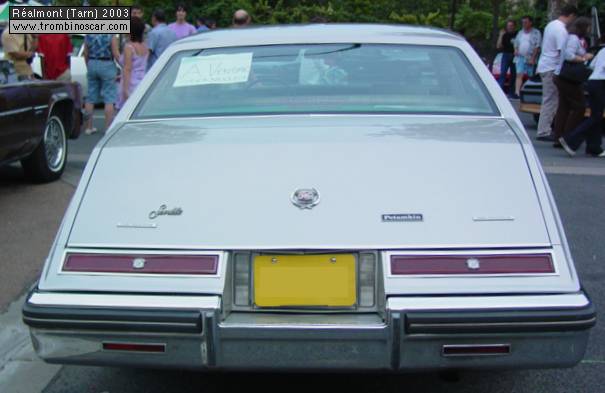|
LES PROPOSITIONS RECUES
pour la Cadillac SEVILLE de
Réalmont
-2-
LAURENT
le 24/06/05 : ce serait une Seville
1980
-4-
JEAN-MARIE
le 19/11/05 : Seville "Elegante" de
1980
-6-
CLAUDE
M
le 23/01/06 : SEVILLE
1980
peut ètre 81 ,modèles identiques,les
changements étant sous le capot. Il ne s'agit
absolument pas d'une "ELEGANTE", toujours livrée en
deux tons accordés,enjoliveurs à rayons et
sigles spécifiques.
-7-
GILLES
le 14/04/06 = modèle
1980/81,
rien à rajouter
-8-
PHILIPPE
V
le 05/06/06 = " Fastback" 1978
/1982
, avec moteur V8. Sur cette version "Fastback" de haut de
gamme ,en fonction de la charge & du style de conduite
du conducteur , un calculateur "déconnectait" 2 ou 4
cylindres par arrêt de l'alimentation en essence (
Electrovalve ) et de l'allumage , puis les remettait en
service , le tout automatiquement . Je ne me souviens
plus très bien , mais , il me semble que la
distribution était aussi " décalée "
lors de la coupure des
cylindres, pour réduire au maximum
l'ouverture des soupapes d'admission ? Un
indicateur digital au tableau de bord avertissait le
conducteur du nombre de cylindres en service . Concept
à priori séduisant , qui a été
abandonné vers1984 , en raison d'une très
mauvaise fiabilité en service du calculateur et de
ses accessoires . Nombre de ces moteurs ont fini
"bloqué" en 4 ou 6 cylindres , voire ont percé
leurs pistons , grillé leurs soupapes , faute d'une
gestion correcte du mélange air essence en
régime "déconnecté" ( Chocs
thermiques lors de la coupure )
INFOS COMPLEMENTAIRES (Source : Cadillac forums.com): en
1980 the 425 was replaced with the L61, which was the same
basic engine de-bored to 3.80 in (96.5 mm) for a total
displacement of 368.3 in? (6.0 L). The reduction in
displacement was largely an effort to meet CAFE requirements
for fuel economy. Fuel injection (which would be known to GM
as throttle-body injection after 1985) was now standard
except for Fleetwood Limousines and Commercial Chassis.
Cadillac refers to the fuel injection system as digital fuel
injection; this particular induction system was later
adopted by other GM division except Oldsmobile V8s. Power
output dropped to 145 hp (108.2 kW) @
3600 rpm and torque to 270 ft·lbf (420.7 N-m)
@ 2000 rpm. This engine was standard on all Cadillacs
except the redesigned Seville, where it was optional.
For 1981 Cadillac introduced what became the most notorious
engine in the company's history, the V8-6-4 (L62). The 368
had not provided a significant improvement in the company's
CAFE numbers, so Cadillac and Eaton Corporation devised a
cylinder deactivation system that would shut off fuel to two
or four cylinders in light-load conditions like highway
cruising, then reactivate them when the throttle was opened.
A dashboard "MPG Sentinel" gauge could show the number of
cylinders in operation, or instantaneous fuel consumption
(in miles per gallon). The L62 produced 140 hp
(104.4 kW) @ 3800 rpm and 265 ft·lbf
(412.9 N-m) @ 1400 rpm. Cadillac hailed the L62 as a
technological masterpiece, and made it standard equipment
across almost the whole Cadillac line (the Seville retained
its standard Oldsmobile-based 5.7 L diesel V8). While
cylinder deactivation would make a comeback some 20 years
later (with modernized technology), Cadillac's V8-6-4 proved
to have insurmountable teething problems, both mechanically
and electronically. The biggest issue was that the engine
control computer was simply not fast enough or powerful
enough to efficiently manage the number of cylinders in
operation, so many of these engines had their
variable-cylinder function disabled by dealers, leaving them
with permanent eight-cylinder operation. The 368 was dropped
for most Cadillac passenger cars after the 1981 model year,
although the V8-6-4 remained the standard engine for
Fleetwood Limousines and the carb 368 remained in the
Commercial Chassis through 1984. "
-9-
PRISCILLIA
le 22/07/06 = modèle
1980
avec son arriere qui se dit
trunkback
-10-
STEPHANE
le 10/12/06 :
1980
on dirait
|



![]()
